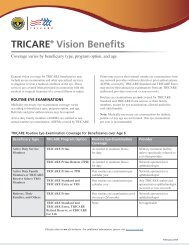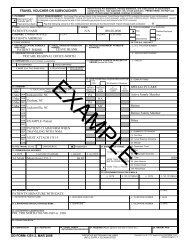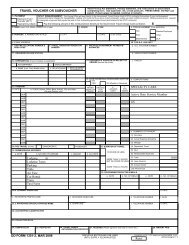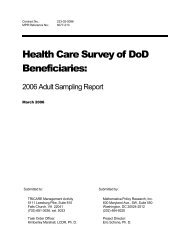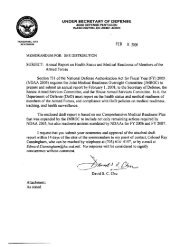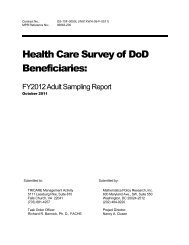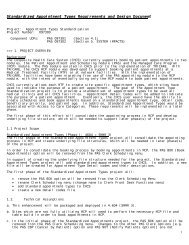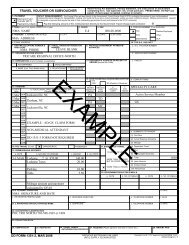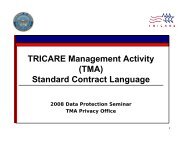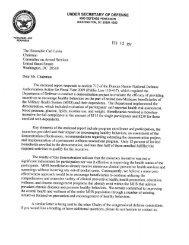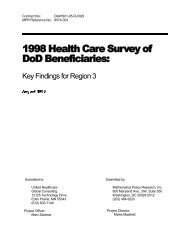Medical Management Guide, 2009, Version 3.0 - Tricare
Medical Management Guide, 2009, Version 3.0 - Tricare
Medical Management Guide, 2009, Version 3.0 - Tricare
- No tags were found...
Create successful ePaper yourself
Turn your PDF publications into a flip-book with our unique Google optimized e-Paper software.
<strong>Medical</strong> <strong>Management</strong> <strong>Guide</strong><strong>Version</strong> <strong>3.0</strong>Disease <strong>Management</strong>Page 107The Current State of Disease<strong>Management</strong>Providers have long strived to return patients tooptimum health. It has only been since the mid-1990s that DM became the program of choice formanaging patient populations (Sprague, 2003).Several driving forces (e.g., congressional mandates,TMA policy, increasing costs) have influenced theMHS’ move to adopt more robust DM practices.There is strong evidence for efficacy of health promotion,disease prevention, and condition managementprograms in both the MHS and the civilianhealthcare arena.Effective DM is a cost-effective approachto enhancing quality of life, postponing thedevelopment of complications, and consistentlyimproving health outcomes for all beneficiarypopulations in the MHS. DM should no longer beviewed as a burden to healthcare teams but ratheras an effective means for improving the futurehealth of defined populations.Managing Chronic Disease in the MilitaryHealth SystemIn the MHS, the incidence of chronic disease inActive Duty Service members (ADSMs) is approximately21 percent (Armed Forces Health SurveillanceCenter, <strong>2009</strong>). However, the vast majority of chronicillnesses in the MHS are present in the retiree andfamily member population. Approximately 30percent of military members remain in the Serviceuntil retirement and become lifetime beneficiaries(Force Readiness and Manpower InformationSystem, 2003). Therefore, the long-term carecoordination and resulting program benefits for thispopulation can be maximally realized in the MHS byleveraging MM resources.In 2005, 133 million people — almost half ofall Americans — lived with at least one chroniccondition (e.g., heart disease, cancer, diabetes).These diseases cause major limitations in dailyliving for almost 1 in 10 Americans (Agency forHealthcare Research and Quality [AHRQ], <strong>2009</strong>). Infact, chronic diseases account for 70 percent of alldeaths in the U.S., or about 1.7 million each year(National Center for Chronic Disease Prevention andHealth Promotion [NCCDPHP], 2008). These diseaseshave a severe impact on quality of life, resulting insignificant increases in individual healthcare costsand the development of conditions that lead to ahigh rate of morbidity.Supporting the link between clinical and businessoperations and evidence-based health care (e.g.,asthma, diabetes, and cancer screening) is includedas one of eight critical initiatives in Tri-Servicebusiness planning (described in Section I, <strong>Medical</strong><strong>Management</strong> Essentials). In accordance with theNDAA of 2007, the MHS placed a greater emphasison integrating DM programs for a variety of diseasesand chronic conditions with enterprise activities.Consequently, the incorporation of evidence-basedmedicine practices and programs has assumeda higher priority in the administration of currentTRICARE contracts. (For more on the link betweenclinical and business operations, see Section I,<strong>Medical</strong> <strong>Management</strong> Essentials. For moreinformation on Tri-Service business planning, seeSection V, <strong>Medical</strong> <strong>Management</strong> Tools.)To support the objectives of their business plans,



